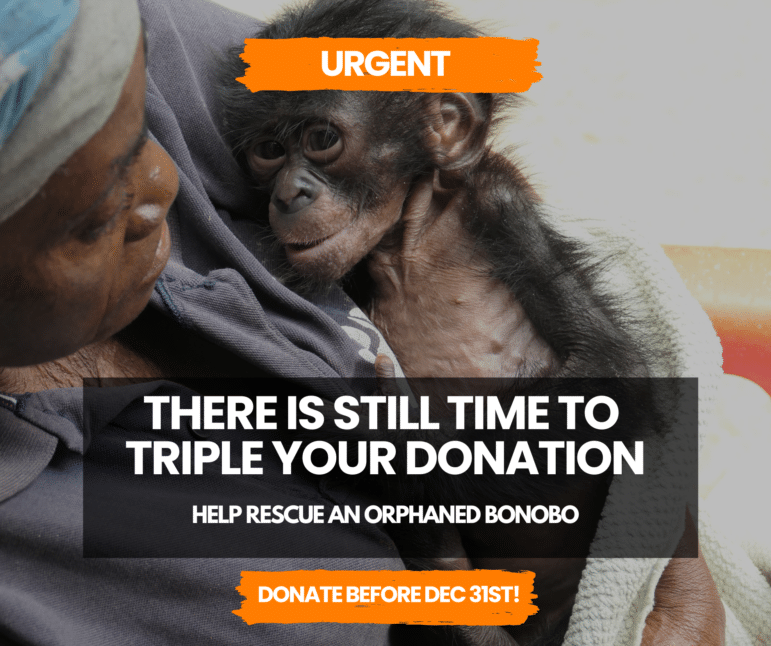Scientists have wondered, too

Bonobo wading in water. Photo: Leon Haberkorn
Water flows through several areas of the leafy wonderland that is Lola ya Bonobo Sanctuary. Visitors delight in seeing the sanctuary’s resident bonobos wading in to catch fruit or other treats tossed by staff members from a boat. The primates sometimes splash in the shallows, as if savoring the pleasures of a bath. They look so comfortable it can be jolting to reflect that bonobos cannot swim.

Staff members Raphael and Stany feeding bonobos on the shore. Photo: Leon Haberkorn
Along with the other great apes (chimpanzees, gorillas, orangutans and humans), bonobos are among the only mammals that lack the instinctual ability to propel themselves through water.
Drop a dog or a calf or a mouse in a river, and it will paddle its way toward the shore. While some monkeys do not swim, some do; proboscis monkeys and crab-eating macaques, for example, are highly proficient in the water. In contrast, should a great ape or human baby find itself suddenly immersed, it will flail ineffectively and quickly go under.
Zookeepers for decades have exploited this aquatic ineptitude to keep captive great apes from escaping from their enclosures; sadly some of those animals have accidentally fallen into water-filled moats and drowned (1).
In the wild, reports of great apes swimming are virtually nonexistent. Zoologist Cintia Garai, who started tracking and observing bonobos in remote regions of the Congo basin more than 14 years ago, says she has never seen any bonobo attempt to swim. Since 2017, Garai has been a scientific advisor to Les Amis des Bonobos du Congo (ABC, Friends of Bonobos of the Congo), and in June of 2021 she became director of the Ekolo ya Bonobo Community Reserve, which consists of intermittently flooded tropical rainforest. Almost 90 percent of Ekolo is typically submerged. The bonobos living there avoid the water, Garai says.

Bonobos eating fruit on a tree stump in the water. Photo: Jabruson/Arcus.
The Congo River – a defining boundary
Bonobos’ inability to swim has been cited to explain why they and chimpanzees developed into two separate (quite different) species (2). Their common ancestor is thought to have lived north of the Congo River. Today the Congo is the deepest waterway in the world, but between roughly one and two million years ago, its flow decreased substantially. Some of the ancestral bonobos managed to cross the riverbed, and when the Congo eventually flooded again, they were marooned.
On the north side, the chimpanzee ancestors faced competition with both ancestral gorillas and their own kind; they developed more aggressive, even war-prone personalities in response, the theory goes (3).
But the animals who had migrated southward faced little competition and evolved into the friendly and cooperative bonobos they are today.
Can Apes Learn to Swim
Various theories have been advanced to explain the lack of inborn swimming ability in apes. One is that they lack buoyancy, unlike humans, who have a higher fat-to-muscle ratio (4). But other terrestrial mammals with negative buoyancy have developed the ability to keep their heads water while moving through it. Even pangolins and armadillos can swim.
Furthermore, in 2013, two biologists for the first time scientifically documented that, given the opportunity, apes can learn to swim (5). In the American Journal of Physical Anthropology, Renato and Nicole Bender extensively documented two separate cases in which captive apes effectively taught themselves to swim and dive.
One was a male common chimpanzee named Cooper raised by a couple in Missouri in the early 2000s. Allowed to play in the shallow end of a backyard swimming pool, Cooper eventually began diving and swimming several meters to a rope stretched over the deep part of the pool, keeping his head above the water and employing something like a human breaststroke kick.
The second animal was a male orangutan held captive in a tourist attraction in Myrtle Beach, South Carolina.
At first wearing a life jacket, Suriya was allowed to play in a pool, and over the course of several years he learned to swim for up to 35 feet or more with his head above the water. Under the surface, he opened his eyes. Both animals learned to hold their breath underwater for 15 seconds or longer.
Life in the Trees
Presenting this evidence, the Benders suggested an explanation for why ancestral apes did not evolve to swim. Because they primarily lived in trees, ancestral apes didn’t normally move around by walking on all fours, unlike other mammals.

Bonobos sitting and eating on a log in the water. Photo: Ariel Rogers
Lacking these fixed patterns of rhythmic action, they lost any instinctive ability to use a doggy paddle when submerged, as other mammals do. As the apes came to avoid water, they probably developed other ways of crossing streams and getting themselves out of it (e.g. leaping over water courses, traveling through the canopy, using fallen logs as bridges, wading bipedally, etc.)
So far there are no reports of any captive bonobos learning to swim and dive.
As the Benders observed in their paper, “Further data are needed to assess the variety of swimming patterns in apes and the influence of environmental factors and social learning processes in the acquisition of this behavior.”
Swimming is just one of innumerable aspects of bonobo behavior and capabilities begging for further exploration and understanding – which is only possible if we take action to help endangered bonobos survive and even thrive.
Jeannette De Wyze was a journalist at the San Diego Reader for 30 years. Today she’s a bonobo lover and supporter and the volunteer liaison between Women’s Empowerment International and the Nyaka Grannies Project in Uganda. She also raises puppies to be service dogs for Canine Companions for Independence and is an active travel blogger.
(1) Cousins D. The reaction of apes to water, with reference to filled moats. Int Zoo News 1978;25:8-13.
(2) Hiroyuki T, Yoshi K, Takeshi F. How did bonobos come to range south of the Congo River? Reconsideration of the divergence of Pan paniscus from other Pan populations. Evol Anthropol 2015;24(5): 170-184. https://onlinelibrary.wiley.com/doi/10.1002/evan.21456
(3) Mitani J, Watts D, Amsler S. Lethal intergroup aggression leads to territorial expansion in wild chimpanzees. Current Biol 2010;20(12):R507-508 https://www.sciencedirect.com/science/article/pii/S0960982210004598
(4) Angus S. Water-Contact Behavior of Chimpanzees. Folia Primatol 1971;14:51-58.
https://doi.org/10.1159/000155333
(5) Bender R, Bender N. Brief Communication: Swimming and diving behavior in apes (Pan troglodytes and Pongo pygmaeus): first documented report. Am J Phys Anthropol 2013;152(1):156-62. https://pubmed.ncbi.nlm.nih.gov/23900964/



